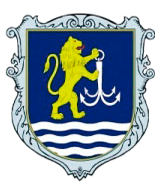RESULTS OF AN EXPERIMENT TO DETERMINE THE RANGE OF SOUND PROPAGATION IN THE SHELF ZONE OF THE BLACK SEA
Abstract
The sound propagation range in the oceans and seas is the most important hydroacoustic characteristic, on which the efficiency of noise-scattering, sonar, density of network hydroacoustic systems of the information layer (positioning and communication) of the automated ship identification system depends. Two methodological (theoretical) aspects of determining the sound propagation range are considered. The first aspect is the determination of the sound propagation range as a function that depends on the frequency of the acoustic wave. The second is the determination of the propagation range of acoustic waves of different lengths as a constant of the number of cycles (wavelengths). For shallow water conditions, the propagation range of acoustic waves is additionally subject to significant dependence on such hydroacoustic characteristics of soils as quantitative indicators of sound reflection and absorption, as well as on the indicator of sound scattering by the sea surface. Obtaining an estimate of the sound propagation range in shallow water has an exclusively experimental solution. For depths of 10–20 m, such an estimate was obtained. At depths of more than 50 m, where an underwater sound channel may exist, the propagation range of acoustic waves can be determined by theoretical methods. The paper presents the results of experimental determination of the propagation range of sound at depths from 20 m to the depths of possible formation of a waveguide. The experiment was performed for the hertz frequency range, which, according to the theory of the propagation range of acoustic waves of different lengths, as a constant of the number of cycles (wavelengths), provides the maximum range of underwater sound communication, sonar and noise direction finding. Data processing of the hydroacoustic experiment to determine the propagation range of sound involves taking into account the refraction of acoustic waves, which forms acoustic shadow zones. To determine the propagation range of sound, it is proposed to determine the acoustic signature (amplitude spectrum), averaged over a certain time, with subsequent detection of the amplitudes of test frequencies as indicators of the intensity of the acoustic signal.
Downloads
References
2. Katsnelson B.G., Petnikov V.G. Acoustics of the shallow sea. Monograph. 1997. 191 p.
3. Ainslie M.A., McColm J.G. A simplified formula for viscous and chemical absorption in sea water. Journal of the Acoustical Society of America. 1998. Vol. 103 (3). P. 1671–1672.
4. Богушевич Б. К., Замаренова Л. Н., Скипа М. И. Дальнє поширення звуку в приповерхневому підводному звуковому каналі північно-західної частини Чорного моря. Акустичний симпозiум «Консонанс-2005». С. 84–89.
5. Cherepantsev A.S. Numerical model of attenuation of acoustic waves in the sea. Anniversary issue “NELAX-2003”. P. 107–1116.
6. Mytko A.V., Popov N.N. Laboratory workshop on the discipline “Marine Information Systems”. 2013. 64 p.
7. Underwater_acoustics. URL: https://en.wikipedia.org/wiki/Underwater_acoustics (дата звернення 01.07.2025).
8. Фесюнов О. Е. Геоекологія північно-західного шельфа Чорного моря. Монографія : АстроПринт. 2000. 100 c.
9. Materials of the second section of the scientific and technical conference “Technical Problems of Marine Resources Development”. September 5 to 30 and October 4, 2013. P. 49–54.
10. Radov V.A. Long-range propagation of sound in the central part of the Baltic Sea. Acoustic journal. 2001. Vol. 47. P. 189–199.
11. Замаренова Л. Н., Скіпа М. И. Акустична модель квазістаціонарних трас. Частина 1. Концепція досліджень. Гідроакустичний журнал (Проблеми, методи та засоби досліджень Світового океану) : зб. наук. пр. Запоріжжя : НТЦ ПАС НАН України, 2009. № 6. С. 10–23.
12. Замаренова Л. Н., Скіпа М. И. Акустична модель квазістаціонарних трас. Частина 2. Оцінка фізичної адекватності акустичної моделі. Гідроакустичний журнал (Проблеми, методи та засоби досліджень Світового океану) : зб. наук. пр. Запоріжжя : НТЦ ПАС НАН України, 2010. № 7. С. 58–72.
13. Burenkov S., Dubrovsky N., Sabinin K. Acoustic monitoring of the Black Sea. Problems of the Black Sea. International Conference. Sebastopol. Ukraine. November 10–15. 1992. P. 101–110.
14. Дивізінюк М. М. Акустичні поля Чорного моря. Держокеанаріум. 1998. 352 с.
15. Бункин Ф. Б., Кравцов Ю. А., Омельченко Н. Н., Петников В. Г., Шмелев А. Ю. Результати дослідження стабільності звукових сигналів на стаціонарних акустичних трасах. Акустичні хвилі в океані. Наука. 1987. С. 84–91.
16. Babiy V.I., Burlakova I.B., Virovlyansky A.L., Demikhovskiy S.V., Kravtsov Yu.A., Kukushkin V.D., Petnikov V.G., Rivelis E.A., Slavinsky M.M., Smirnov N.M., Farfel V.A., Shmelev A.Yu. Stationary acoustic path Crimea-Caucasus . Acoustics of the ocean environment. Science. 1989. P. 75–79.
17. Furduev A.V. Acoustic monitoring of underwater environment variability (experimental verification of new methods). Acoustic Journal. 2001. Vol. 47 (3). P. 422–430.
18. Belogortsev A.S., Belov A.I., Zhuravlev V.A., Khokha Yu.V. Acoustic models of shelf marine waters and the problem of their physical adequacy. Proceedings of the Nizhny acoustic scientific session. 2002. P. 64–67.
19. Кучеренко Н. В., Капочкін Б. Б., Капочкіна М. Б. Прикладні аспекти закономірності процесу поглинання енергії акустичних хвиль у воді. Водний транспорт. 2025. Випуск 2 (43). C. 20–30. doi.org/10.33298/2226-8553.2025.2.43.02.
20. Ocean Acoustics/Underwater Acoustics. URL: http://www.tsuchiya2.org/(дата звернення 02.07.2025).
21. Fisher F.H., Simmons V.P. Sound absorption in seawater. Journal of the Acoustical Society of America. 1977. Vol. 62. P. 558–564.
22. Francois R.E., Garrison G.R. Sound absorption based on ocean measurements: Part I:Pure water and magnesium sulfate contributions. Journal of the Acoustical Society of America. 1982. Vol. 72 (3). P. 896–907.
23. Francois R.E. Garrison G.R. Sound absorption based on ocean measurements: Part II:Boric acid contribution and equation for total absorption. Journal of the Acoustical Society of America. 1982. Vol. 72 (6). P. 1879–1890.
24. Богушевич Б. К., Замаренова Л. М., Скіпа М. І. Структура звукового поля на шельфі північно-західної частини Чорного моря: експеримент Консонанс-2005. C. 182–188.
25. Гладких І. І., Каналюк О. В., Капочкін Б. Б. Вплив рефракції звуку в Азово-Чорноморському районі на ефективність пошуку цілей гідролокаторами кругового огляду. ScienceRise. 2018. № 2. С. 14–18.

This work is licensed under a Creative Commons Attribution 4.0 International License.





